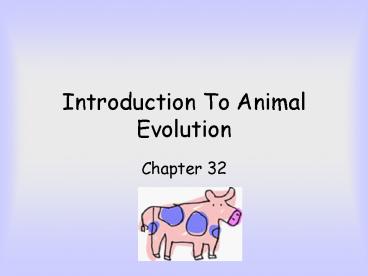Introduction To Animal Evolution - PowerPoint PPT Presentation
1 / 25
Title:
Introduction To Animal Evolution
Description:
Some organisms - body cavity - not completely lined by mesoderm. Pseudocoelomates include rotifers (phylum Rotifera), roundworms (phylum Nematoda). – PowerPoint PPT presentation
Number of Views:109
Avg rating:3.0/5.0
Title: Introduction To Animal Evolution
1
Introduction To Animal Evolution
- Chapter 32
2
- Animals 1st appeared in Precambrian in waters,
spread to land. - 5 criteria that define animal
- 1Animals multicellular, must get food through
ingesting other organisms or organic material.
3
http//www.biology.wustl.edu/plant/simplealgalsyst
ems1.jpg
4
- 2Animals do not have cell walls.
- 3Animals have nervous tissue to conduct impulses
and muscle tissue for movement. - 4Most animals reproduce sexually with diploid
stage being dominate. - 5Animals have special regulatory genes (Hox
genes) help zygote form into animal.
5
(No Transcript)
6
(No Transcript)
7
(No Transcript)
8
Branching of evolutionary tree
- 1st branch point splits Parazoa (lack true
tissues) from Eumetazoa (true tissues). - Parazoa include sponges.
- Eumetazoans divided into 2 major branches, partly
based on body symmetry.
9
http//www.sciencedaily.com/images/2007/07/0707051
53000.jpg
10
- Radial symmetry - phylum Cnidaria and phylum
Ctenophora. - Bilateral symmetry (left and right side) - rest
of phyla.
11
(No Transcript)
12
- Bilateral symmetry - cephalization, -
concentration of sensory equipment towards head. - Difference between 2 groups - presence of germ
layers - layers of embryonic tissue that form
various tissues and organs.
13
http//www.guam.net/pub/sshs/depart/science/mancus
o/apbiolecture/27_Animalia/Annelida/Image11.gif
14
- Bilaterally symmetric animals - 3 germ endoderm
(innermost), mesoderm (middle) ectoderm
(outermost). - Bilateral animals split according to presence of
body cavity (fluid-filled space separating
digestive tract from outer body wall) and what
cavity looks like.
15
http//universe-review.ca/I10-13-layers.jpg
16
- Acoelomates (phylum Platyhelminthes) have solid
body, lack body cavity. - Some organisms - body cavity - not completely
lined by mesoderm. - Pseudocoelomates include rotifers (phylum
Rotifera), roundworms (phylum Nematoda).
17
(No Transcript)
18
(No Transcript)
19
- Coelomates organisms with true coelom,
(fluid-filled body cavity completely lined by
mesoderm). - Body cavity has many purposes including
cushioning organs, allowing them more room to
grow.
20
(No Transcript)
21
(No Transcript)
22
- Coelomate phyla divided based on differences in
development. - Many protostomes (mollusks, annelids, arthropods)
undergo spiral cleavage. - In many protosomes, blastopore develops into
mouth 2nd opening at opposite end of gastrula
develops into anus.
23
http//chsweb.lr.k12.nj.us/mstanley/outlines/anima
ls/antax/image51.gif
24
- Zygotes of many deuterostomes undergo radial
cleavage. - Deuterostomes - blastopore usually develops into
anus, mouth derived from 2nd opening.
25
(No Transcript)































